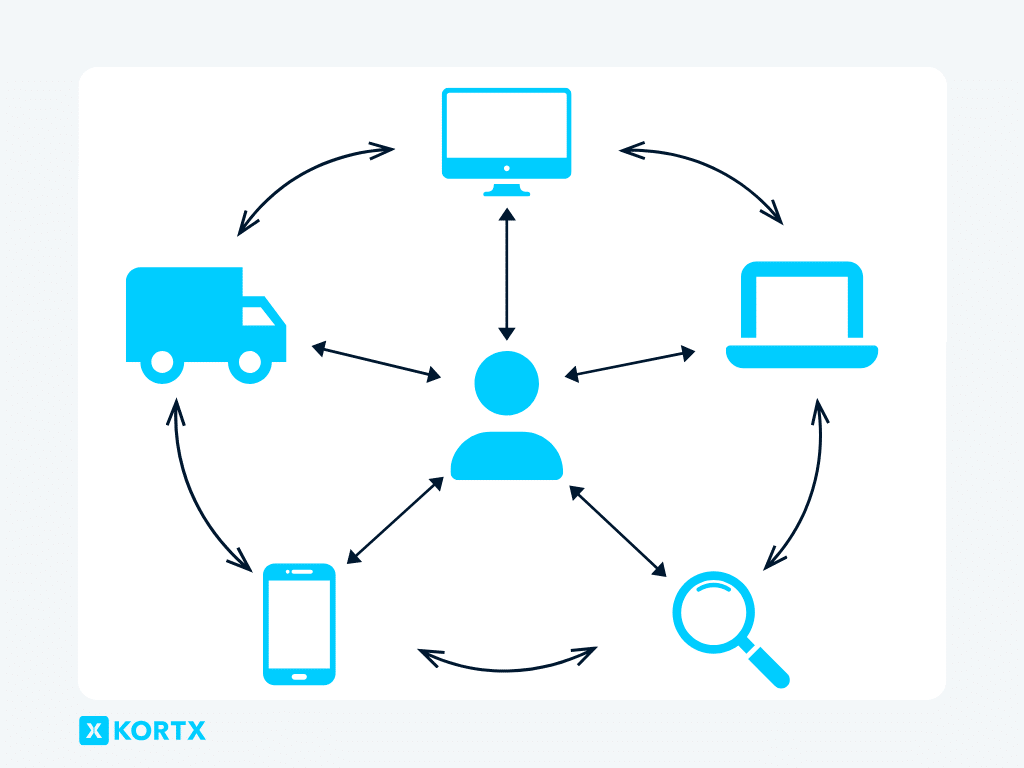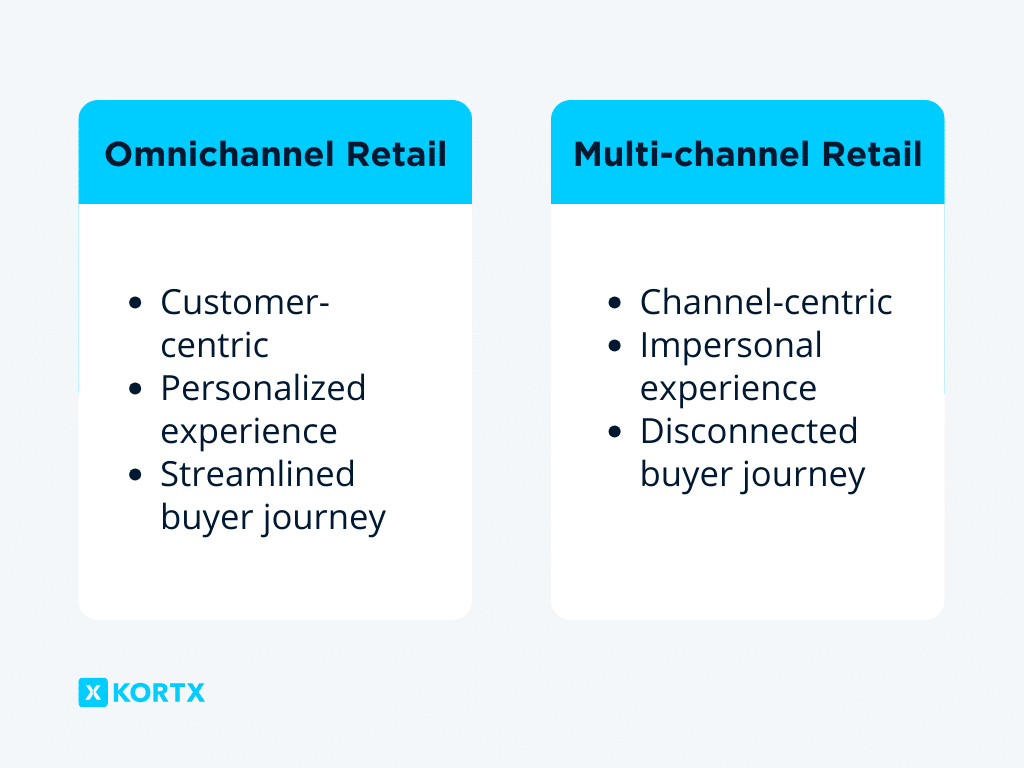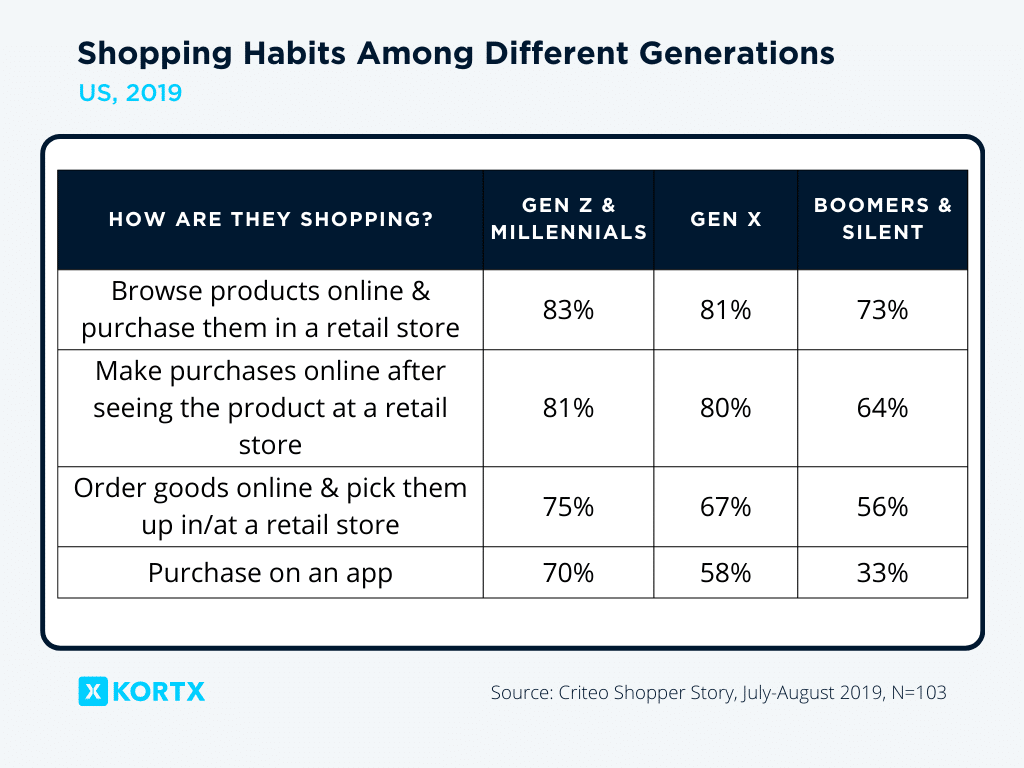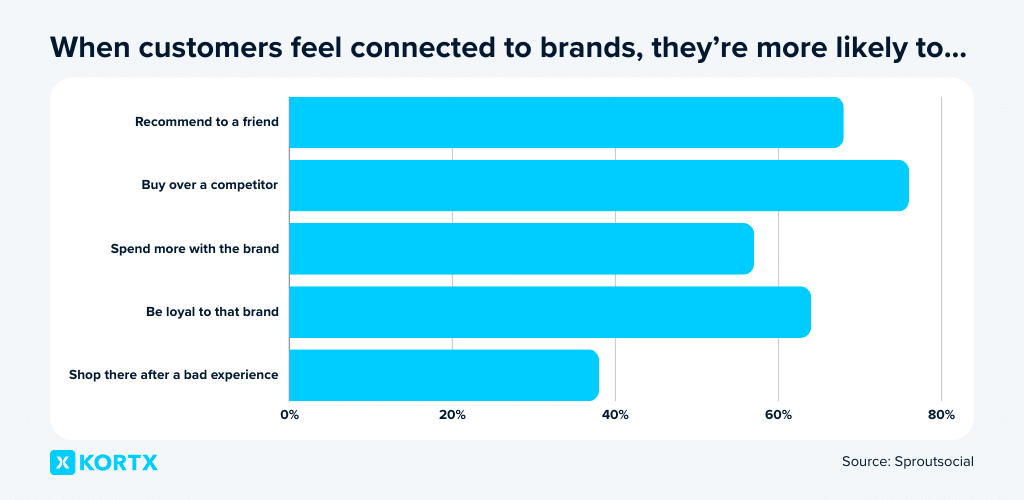Customers want a seamless experience with your brand, regardless of where they interact with it.
Omnichannel retail marketing addresses this by integrating various shopping platforms – such as online websites, physical stores, and mobile apps – to offer a consistent and unified customer experience.
This article delves into the key benefits of adopting an omnichannel approach, highlighting its role in improving customer satisfaction and boosting your company’s sales.
What is Omnichannel Retail?: A Definition
Omnichannel retail, also called omnichannel retailing, provides a cohesive experience across all consumer channels and touchpoints. This includes in-store, online, and in-app. The goal is to provide a seamless experience throughout the entire purchasing process.
What is an example of an omnichannel retail experience?
A customer may begin by exploring a product through a mobile app or website, then view it in-store, and finally make the purchase online. Meanwhile, a warehouse robot pulls the item for order fulfillment, triggering automatic updates to inventory records.
With this data, a brand can design future targeted promotions, project future inventory needs, and use purchase data to drive demand from other customers.
Omnichannel success: Harvard Business Review survey results
An HBR survey showed that omnichannel shoppers spend an average of 4% more every time they’re in a store and spend 10% more when shopping online.
Successful omnichannel retail strategies allow customers to choose their preferred transaction channel and method while making cross-channel transactions convenient.
Advancements in information technology like AI (Artificial Intelligence) and data analytics have simplified monitoring a customer’s journey across various touchpoints. This includes tracking from paid social media advertisements and interactions to QR codes in Connected TV (CTV) ads, email marketing campaigns, and more.
Omnichannel vs. Single-channel vs. Multichannel Retailing
Single-channel retailing is the traditional model focusing on one sales channel based on a single-distribution system. For example, a retailer only runs a brick-and-mortar store (offline) or a web store (online).
In the pre-digital era, the single-channel model was sufficient for budget-focused businesses. Now, this approach is considerably limited due to increased touchpoints across multiple digital channels and devices.
Multi-channel retailing became the answer to this. Multichannel is an easy way to say your brand operates on multiple channels like social media, phone, email, and chat.
Retailers provide both online and offline purchasing options but often face challenges in unifying the customer experience across these channels, leading to inconsistencies in inventory, pricing, and service.

Omnichannel retailing integrates multiple marketing channels using centralized data management and other tools for a seamless customer experience.

Customers can simultaneously use different avenues during the purchase process. They can start their search on one channel, like social media, and finish it on another, like in-store.
Marketers can adopt an omnichannel strategy in sales channels, inventory management, and overall marketing strategy.

The 5 Top Omnichannel Retail Trends in 2024
Black Friday shopping went from hours-long lines in the cold outside of Best Buy to shopping online from the convenience of one’s couch. Shopping preferences are constantly evolving and changing, so retailers must adapt.
Below are some of the leading omnichannel retailing trends of 2024, offering insights to stay at the forefront of the ever-changing landscape.
1. All Generations Like Omnichannel Shopping–But Especially Younger Ones
Criteo found that younger generations exhibit omnichannel shopping behaviors more than older generations. 83% of US Gen Z and Millennials browse products online and then purchase them in-store (webrooming), and 81% make purchases online after seeing the product at a retail store (showrooming).

In-app shopping is also notably more popular among these younger demographics. Around 70% of Gen Z and Millennials make purchases through apps, starkly contrasting the 33% observed among Boomers and the Silent Generation.
Integrating digital and physical retail experiences is an imperative trend to cater to the shopping preferences of younger generations.
2. People Love Buying Online, Picking Up In Store (BOPIS)
Buy Online, Pick Up in Store (BOPIS), also called click-and-collect, allows retailers to blend online and in-store experiences to engage customers while offering a more convenient shopping method.
BOPIS originally picked up popularity during the pandemic. Now, BOPIS retail sales are projected to jump from $96 billion USD in 2022 to $154 billion by 2025.
59% of consumers say they’re likely to purchase online and buy in-store, with 54% likely to look at a product in-store and buy online.
The most common reason customers shop in-store is to touch and try on items in the store. BOPIS satisfies those customers who prefer to purchase online without waiting for shipping and try it in-store before fully committing.

Offering BOPIS also incentivizes more online shoppers to visit your store. Customers get fast and free shipping while you minimize shipping (and potentially returned items) costs.
3. AI is Improving the Purchase Process
AI is becoming increasingly integral to omnichannel retailing, enhancing various aspects of the shopping experience. This includes:
- Personalized product recommendations based on customer browsing and purchase history.
- Faster customer service through AI-powered chatbots.
- Improved inventory management that synchronizes stock levels across different channels.
AI & Customer Personalization Stats
Personalization plays an important role throughout the entire customer lifecycle.
- The AI customer personalization software market hit $943 million in 2022 and may reach $2.7 billion by 2027.
- 78% of consumers say they’re more likely to recommend brands that personalize and make repeat purchases.
- 52% of consumers agree that personalization improves brand satisfaction.
AI-driven predictive analytics helps retail advertisers anticipate customer needs and preferences. Generative models can synthesize realistic user data to model hypothetical target audiences.
Advertisers can describe their ideal customers, and the models can produce anonymized data capturing essential attributes. This means you can optimize campaigns without access to sensitive user data.
4. Multichannel Attribution to Track Online & Offline Sales
As omnichannel retailing grows, marketers increasingly focus on verifying that their online campaigns drive offline sales. Multichannel attribution tracks and analyzes the customer’s journey across various channels to determine which interactions led to a sale or desired action.
How are brands measuring the success of omnichannel marketing campaigns?
“Companies embracing multiple sales channels are now aiming to gain analytics that provide a comprehensive view of customer journeys. These journeys often transition between online and offline environments and back again.
The most critical aspect of multichannel attribution is to meet customers wherever they are, across different channels. Then, leveraging cross-channel analytics becomes pivotal to evaluating your omnichannel strategies’ performance.”
Using data from various touchpoints (social media, online ads, email campaigns), advertisers use multi-channel attribution to create a unified customer profile, consolidating customer interactions and behaviors across all channels.
Retailers use this data to identify which channels and touchpoints are most effective in driving sales or other desired outcomes.
5. Building Connections Through Social Selling
Social selling uses social media platforms to locate, engage with, and cultivate relationships with potential customers. This strategy contrasts traditional advertising, often directly promoting products to consumers by emphasizing their benefits or problem-solving capabilities.
Social selling focuses on building meaningful relationships and providing value to potential customers before proposing a sale. Connection directly impacts a brand’s bottom line. More than 76% of consumers say they would buy from a brand they feel connected to over a competitor.
When consumers don’t feel connected to a brand, they’re 70% less likely to shop there over a competitor, and 61% will spend less in general with that business.

By investing in this relationship-building process, social sellers enhance their likelihood of converting prospects into customers, thereby driving increased sales.
📚 Related Article: 17 Holiday Shopping Trends to Consider (2023)
Want more trends? Check out our 2023 holiday marketing trends to stay ahead this season.
Notable Strategies & The Future of Omnichannel Retail
Omnichannel retailing provides a seamless shopping experience across online and offline channels.
Here are recommended strategies for enhancing your omnichannel retail approach.
1. Use First-Party Data for a Thorough Audience Understanding
Understanding your audience is the key to a successful omnichannel retail strategy. This includes analyzing demographic data, purchase history, and browsing habits through First-Party data collection.
Collecting data is easy through a Customer Relationship Manager (CRM), site tagging, and tools like Axon Audience Manager.
Axon can identify potential customers who share similar characteristics with your existing customers (lookalike audiences), even without traditional tracking methods like Third-Party cookies.
How are brands measuring the success of omnichannel marketing campaigns?
“Many agencies and brands perceive the process of gathering and analyzing First-Party data as complex and laborious, but in reality, it’s quite straightforward. For instance, with the right tools, you could be up and running, collecting valuable First-Party data in just a few days. The real challenge often lies in internal logistics, particularly when multiple stakeholders are involved in different aspects like web development, marketing data, and tag management. Gaining approval from various parties can be the main hurdle.
Moreover, there are some lingering, albeit unfounded, privacy concerns. While these might have been more relevant 15 years ago, today’s data collection primarily involves anonymous, basic information, making these concerns less pertinent, except in regulated industries like healthcare.
It’s surprising how some, particularly in sectors like retail, still don’t prioritize understanding customer interactions on their websites — how customers navigate, what they’re buying, or why items are added to a cart but not purchased. These insights, gleaned from First-Party data, are invaluable, and collecting it should be a top priority for businesses.”
What the Future Will Look Like
With the impending changes due to Google’s cookie deprecation, the focus is shifting towards the importance of First-Party data. Brands and agencies are now urged to maximize their use of this data. This means deeply understanding customer habits, and ensuring up-to-date CRM lists. Despite the uncertainty about future data collection and usage methods, First-Party data’s value remains high, directly linking consumer behaviors and preferences.
Omnichannel Retail Starts with First-Party Data
Axon leverages First-Party data for comprehensive customer profiling and behavior analysis across platforms, domains, and locations.
Understand how your customers interact with your brand across all your touch points.
2. Integrate Online and Offline Channels
Connecting online and offline channels means ensuring customers can transition between different shopping methods–from browsing products on a website or app to checking inventory or product details in a physical store, and vice versa.
To achieve this, it’s important to maintain consistency throughout several key areas:
- Consistent pricing and promotions: Ensure pricing and promotional offers are uniform across all channels. Customers should find the same price for an item online, through a mobile app, or in a brick-and-mortar store.
- Unified product availability information: Your inventory management system should be integrated across all channels. This allows customers to check the availability of products in real-time, regardless of where they are shopping. Product information, including specifications, reviews, and images, should be consistent and up-to-date across all platforms.
- Integrated customer service: Provide a unified customer service experience. Whether a customer contacts you through social media, a call center, or in a physical store, service quality and information provided should be consistent. Integrating customer service channels also makes the customer’s history and previous interactions accessible.
- Cross-channel returns and exchanges: Simplify the returns and exchanges process by allowing them across different channels. A customer should be able to return or exchange an online purchase at a physical store and vice versa.
- Synchronized loyalty programs: Loyalty programs should be accessible and usable across all channels. Customers should be able to earn and redeem points or benefits whether they shop online or offline.
While different retailers can decide how best to implement these strategies based on their business models and customer base, the underlying goal remains the same: to create a unified, customer-centric shopping experience.
What the Future Will Look Like
Offering a seamless, cross-channel customer service experience will remain important. With technologies like AI chatbots becoming more advanced, customers will receive consistent, high-quality service whether they shop online, in-app, or in physical stores.
3. Keep Communications Personalized
Personalization is critical to a superb customer experience and driving engagement in omnichannel retailing. It involves tailoring communications to meet customers’ needs and preferences based on their previous interactions, purchase history, and preferences.
Once you have First-Party data, you can further personalize your customer interactions. Analyze purchase history and browsing behavior to offer personalized product recommendations through marketing communications.

For example, Etsy sends email recommendations based on a recipient’s browsing or purchase history. Offering 15% off entices the recipient to revisit the product they showed interest in.
With personalization, the recipient feels that the offer is curated specifically for them, making them more likely to buy.
🤔 Why should you personalize your marketing efforts?
80% of consumers will share personal data in exchange for deals or offers.
What the Future Will Look Like
As AI advances, it will help drive more personalized shopping experiences. AI will revolutionize inventory management by accurately predicting demand patterns and optimizing stock levels across multiple channels.
4. Incorporate Augmented (AR) & Virtual Reality (VR)
Augmented and virtual technologies offer customers a more immersive shopping experience, such as trying on clothes virtually or visualizing how furniture would look in their homes before making a purchase.
At the point of sale (POS), AR offers customers a “try-as-you-buy” experience, which can help reduce returns. One study found that customers who used AR to try a product were less likely to send the purchases back.

Ulta, a beauty retailer, allows customers to virtually try on makeup before buying it.
What the Future Will Look Like
Augmented reality (AR) and virtual reality (VR) are anticipated to grow, generating revenue of $32.1 billion worldwide in 2023. As AR and VR become more sophisticated and accessible, they will continue transforming the consumer shopping experience.
AI algorithms could analyze a customer’s previous purchases and browsing history to recommend products that can be visualized in their personal space through AR.
5. Sell Your Products & Services Through Social Commerce
Social commerce is where merchants sell products directly to consumers through social platforms. Although it’s a small part of retail sales, it’s a rapidly growing segment in the United States.

Omnichannel strategies will increasingly need to include social channels as key touchpoints in the customer journey. Platforms like Instagram and TikTok already integrate shopping features, blurring the lines between social media and eCommerce.
TikTok recently launched TikTokShop so that users can purchase from brands directly in-app.
What the Future Will Look Like
Retailers will offer highly personalized shopping experiences on social platforms using AI algorithms and data analytics. Customers will receive product recommendations and promotions tailored to their preferences and past behavior, both on social media and across other channels.
What does the future of omnichannel retailing look like?
“I firmly believe that AI and data analytics represent the future of omnichannel retail. These technologies are crucial in understanding and responding to the growing trend of personalization in consumer behavior, allowing for the creation of tailored experiences across multiple platforms. This strategic focus on individualized customer engagement, driven by AI’s advanced capabilities, is not only enhancing the shopping experience but also setting new standards in the retail industry.”
Overall, the future of omnichannel retail promises a more connected and immersive shopping experience driven by technological advancements and changing consumer expectations.
Delivering A Consistent Customer Experience
Modern consumers want to shop on their own terms. A customer-centric strategy is key to delivering them what they want when they want it, and wherever they want to get it.
With its seamless integration across various channels, omnichannel retail is perfectly poised to meet these expectations. It ensures that customers enjoy a uniform and satisfying experience. Ultimately, the success of omnichannel retail lies in its ability to adapt to consumers’ evolving preferences, offering them a shopping experience that is not just convenient but also uniquely tailored to their needs.
Customers may spend >18% for an omnichannel experience. How’s your strategy?
Evaluate your strategy with our expert team and see how you can enhance your omnichannel approach & meet customer expectations.
About the Author
Erik Stubenvoll is a Managing Director at KORTX with over 20 years of experience. When he is not learning about his client’s goals, he is on the sidelines with his wife at his daughter’s softball and soccer games or on the golf course.



